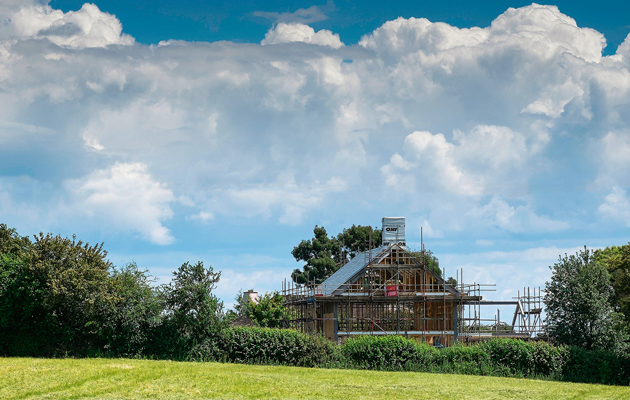Know you rights: restrictive covenants
Pippa Cuckson reveals the burdens and benefits of pre-existing covenants.

Despite the recent pressure from Westminster to release greenfield sites in villages for the development of new houses, ancient restrictive covenants over development remain enforceable in 21st-century Britain. Landowners are, however, often unaware that their predecessors may have taken out these covenants, which effectively control what can be built or how the land may be used, when they sold off parcels of their estate decades before.
This is because covenants are listed on the deeds of the property restricted by them (the ‘burdened’ party), but not on the deeds of property enjoying the control (the ‘beneficiary’). They may only be spotted after a painstaking search of old transfer records at the Land Registry.
The happy discovery that one benefits from a covenant can, however, lead to significant legal expense before the offending development is stopped or compensation received. Covenants cannot be cited to see off a development at local-council planning level and if pre-build negotiations fail, the beneficiary’s principal weapon is High Court proceedings for an injunction and/or damages in lieu.
The developer can apply for the covenant to be discharged or modified by the Upper Tribunal, Lands Chamber (previously the Lands Tribunal), although it’s a high-risk endeavour for them. Solicitor Richard Bartle of Pinsent Masons (www.pinsentmasons.com; 020–7418 7000), who has special interest in this niche field, says the difficulty in overturning covenants is evidenced by only ‘a few hundred applications in the past 10 years’.
The main grounds for discharge are ‘obsolescence’, such as an ancient covenant prohibiting the site’s association with the Catholic Church or the covenant no longer serving any practical benefit to the people trying to enforce it. This might include loss of privacy, views or reduced value of property. The existence of planning permission rarely cuts much ice at tribunal, but developers sometimes press on with the build, gambling that no court would order demolition or disagree that, in this day and age, covenants taken out many decades ago impede ‘a reasonable use of the land’.
In a now infamous case from 2011, house builders Taylor Wimpey started work on 124 new homes at Prestbury, near Cheltenham in Gloucestershire, including 24 on just under two acres protected by a 1936 covenant. The tribunal said that, even if it had been inclined to modify the covenant, this would have been inappropriate in the light of Taylor Wimpey’s overt ‘flouting of its legal obligations’. The company thus tore the houses down.
Mr Bartle says escalating property values have led to what he describes as a ‘feeding frenzy’ in London over covenanted sites developers might previously have avoided. One such is a tiny green space in Holland Park, W11, sold for development in 1965, but left overgrown by brambles for 40 years due to a covenant empowering neighbours to approve all design plans in advance. This was finally challenged in 2013 by the architect Sophie Hicks. The court ruled the covenants were valid, but that neighbours should not ‘unreasonably’ withhold consent. Ironically, the Royal Borough of Kensington and Chelsea then rejected her subsequent planning application.
Sign up for the Country Life Newsletter
Exquisite houses, the beauty of Nature, and how to get the most from your life, straight to your inbox.
The Law Commission has recommended clarifications to covenant law, but there is no confirmation of when Parliament might review them. In the meantime, Mr Bartle strongly advises potential developers not to lift a brick until they’ve identified any covenants and reached agreement with those affected. ‘You often see that the beneficiaries’ concerns are not the same ones the planners had,’ he says. ‘As things stand, the law hasn’t changed. It’s an uphill struggle at tribunal, even though it’s been done on rare occasions.’
He adds: ‘If beneficiaries agree to negotiate, they can be entitled to a large cut of the profit, although valuations in rural areas don’t always justify the legal fees. They’re more likely to achieve a good win in an urban area.’
One rare and partial victory in 2012 was achieved by purchasers of part of a Northumberland sporting estate. They believed their redevelopment plans for an existing house and farm buildings had found favour with the seller—who, nonetheless, applied a covenant and lodged an objection. The tribunal felt that the seller’s action was primarily a ruse for compensation and branded as ‘absurd’ his claim for loss of privacy because of a window overlooking a disused family burial ground 550 yards away.
-
 Burberry, Jess Wheeler and The Courtauld: Everything you need to know about London Craft Week 2025
Burberry, Jess Wheeler and The Courtauld: Everything you need to know about London Craft Week 2025With more than 400 exhibits and events dotted around the capital, and everything from dollshouse's to tutu making, there is something for everyone at the festival, which runs from May 12-18.
By Lotte Brundle Published
-
 Everything you need to know about private jet travel and 10 rules to fly by
Everything you need to know about private jet travel and 10 rules to fly byDespite the monetary and environmental cost, the UK can now claim to be the private jet capital of Europe.
By Simon Mills Published
